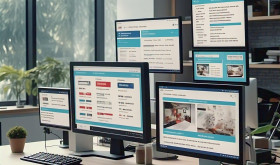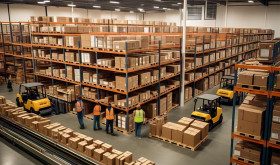
In today’s changing economic scene, warehouses play a crucial role in supply chain strength—or failure. With worldwide worker shortages and rising operation costs, businesses must reconsider how their warehouses work. Many find the solution in starting or improving a Warehouse Management System (WMS).
The Economic Pressures Warehouses Face in 2025
Let’s be real—running a warehouse has always been a challenge. But things have gotten even more difficult.
🔹 Labour Shortages Are Everywhere
This isn’t just a problem in one country—industries worldwide are struggling to find workers. The warehousing sector has taken a big hit, whether because of aging populations, changing worker expectations, or shifts in workforce participation after the pandemic.
A recent McKinsey study shows that in 2024 almost 70% of warehouse operators in the Asia-Pacific region had trouble hiring and keeping workers.
🔹 Costs Are Going Up
From electricity bills and rent to transport and packing supplies, running costs keep growing. Mix in higher minimum wages in many areas and inflation, and you face a perfect mix of climbing expenses.
This is where tech comes in—and where Warehouse Management Systems show their value.
What Is a Warehouse Management System?
A warehouse management system is software that helps control and improve warehouse tasks. It monitors stock, guides picking and packing, handles incoming and outgoing shipments, and works with other systems like ERP and transport management tools.
But in 2025, warehouse transport management does more than just sort goods—it’s a smart core that boosts productivity, insight, and flexibility.
- Addressing Worker Shortages Through Automation and Better Efficiency
Let’s begin with the biggest problem right now: not having enough people to complete the work.
✅ Making Repetitive Jobs Automatic
A warehouse management system helps get rid of boring, repeated jobs like counting stock by hand or dealing with paperwork by making them automatic. Things like scanning barcodes, tracking with RFID, and giving picking instructions on mobile devices mean workers spend less time looking for stuff and more time moving it around.
✅ Smarter Ways to Manage Workers
New warehouse management systems come with ways to predict how many workers you’ll need and share the work. This makes sure jobs are spread out, work schedules are set up in the best way, and even new staff can learn by using easy-to-understand dashboards.
✅ Less Time Needed for Training
Training fresh employees is time-consuming—something warehouses under pressure don’t have. With easy-to-use warehouse management system interfaces and step-by-step workflows, getting new hires up to speed happens quicker, lowering reliance on seasoned staff.
“We used to spend weeks training new staff,” a Singapore-based warehouse supervisor told me. “Now, with the warehouse management system, we have them picking orders by Day 3.”
- Fighting Increasing Expenses Through Operational Visibility
When every cent matters, waste becomes too costly. This is where a warehouse management system stands out.
✅ Real-time Inventory Control
Missing or misplaced stock costs money—either through missed sales or urgent reordering. A warehouse management system provides you with live insights across every shelf, pallet, and SKU boosting accuracy.
✅ Space Optimisation
The warehouse management system examines storage trends and helps make the best use of shelves and bins. This puts off the need to expand warehouses, which costs a lot, and makes picking more productive.
✅ Fewer Mistakes = Lower Costs
Sending the wrong item leads to returns, refunds, and extra work—each adding to your expenses. With tools like automatic order checks and smart picking routes, warehouse management system cuts down these mistakes by a lot.
A logistics company had cut picking errors by 92% in just 6 months after they started using their WMS. This saves money and builds customer trust right away.
- Enhancing Customers Experience Amid Supply Chains Disruption
Here’s something many companies don’t realize: a smooth warehouse operation leads to happier customers.
A warehouse management system has an impact on speeding up order fulfilment , improving order accuracy, and providing current tracking details. In an era when customers want instant updates and quick delivery, this can determine the success or failure of your brand.
Factor in the capability to sort priority orders, work with third-party logistics companies, and provide same-day shipping in specific areas—and your warehouse suddenly becomes a strategic edge.
- Getting Ready for What’s Next with Predictive Analytics
One of the most useful features of modern warehouse management systems is data intelligence.
Using past and current data, warehouse management can help you predict demand, schedule seasonal workers, and spot slow-selling or popular items.
For instance:
- Do some products sell more during school breaks?
- Are certain areas in your warehouse slowing things down?
- Does your team always lag behind on Fridays?
Warehouse management system can highlight these patterns and help you tackle them—before they turn into costly issues.
Bonus: Environmental and Regulatory Advantages
Many businesses now work under green goals or government rules. A warehouse management system helps to:
- Cut down waste by improving stock turnover
- Back eco-friendly packaging choices
- Allow tracking for checks or product recalls
Especially in places like the EU or Singapore where ESG reporting is getting stricter, having a digital system to back up compliance isn’t just a choice anymore.
Conclusion: It’s Time to Invest in a warehouse management system
The hurdles of 2025 are real—worker shortages rising costs, and growing customer demands are putting major stress on warehouses worldwide.
But these challenges also bring a chance for growth.
A Warehouse Management System isn’t just new software—it’s a key investment in your company’s ability to change, grow, and succeed in a tough market.
If your warehouse still uses spreadsheets, paper forms, or old systems, it’s time to make a move. A new warehouse management system will help you achieve more with fewer resources, build strength, and keep up with rivals in a shifting landscape.
Last Thought: Picking the Best WMS
Not every warehouse management system platform is the same. If you’re a small online seller or a regional distributor, look for a solution that:
- Scales as you expand
- Works with your current systems
- Gives you mobile access and cloud options
- Provides local help and is easy to use
Begin with a small setup if you need to—but get started now.
In today’s warehouse, being efficient isn’t just something to aim for—it’s survival.










